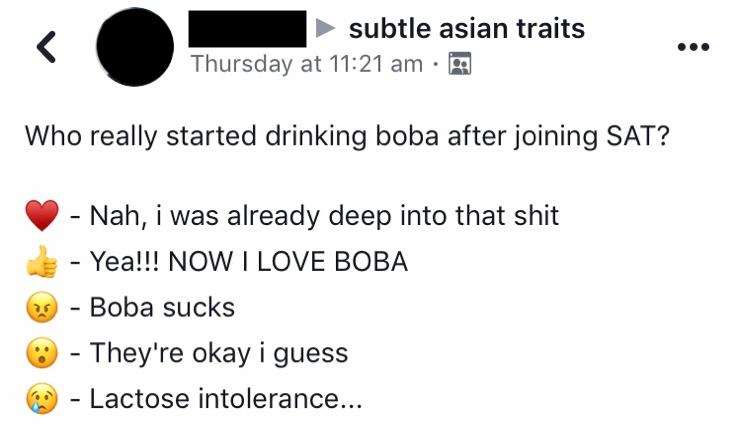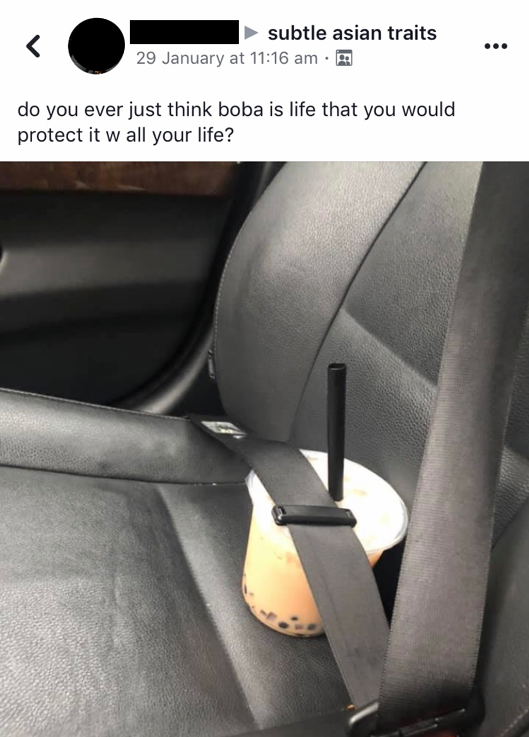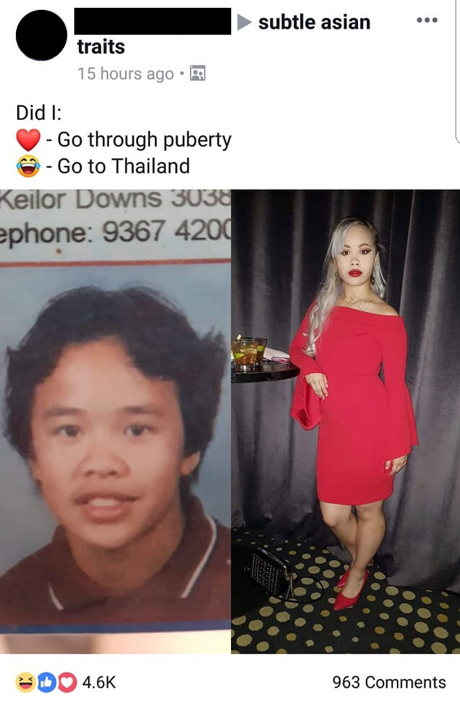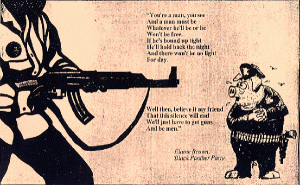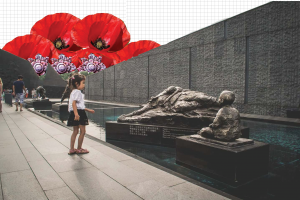
[Not-So] Subtle Asian Traits
by Claire Soh | August 1, 2019
A 2am Facebook notification was the gateway to hours scrolling away and lecture slots suppressing my laughter. My cousin, a student at Tufts University across the Atlantic, had added me to a Facebook group I’d never even heard of: subtle asian traits.
“subtle asian traits” is anything but subtle. Founded by a group of Asian-Australian university students in mid-2018, the online community has grown to a whopping 1.1 million members from all corners of the globe. When I joined the group in December 2018, it had barely half that number, and membership continues to rise. The allure of the group is its relatability. A quick scroll through the page reveals screengrabs of a surprised Pikachu, laments about being made to aim for medical school, and memes extolling the joys of drinking bubble tea. Members contribute anecdotes about home-cooked meals and recommendations for the best eateries in Asian food hotspots that garner thousands of reactions.
For the next few nights, I’d settle into bed, intending to idly scroll through the posts before going to sleep, only to spend two hours love-reacting to every vaguely relatable meme there was. With every friend I tagged, I added to comments sections filled with people tagging their friends, comments along the lines of “OMG THIS IS ME”. Often, I saw old classmates from my native Singapore, fellow Singaporeans in Oxford, and friends and family in the USA all tagged in the same posts. Sometimes, I had to turn off notifications for posts that I’ve tagged someone in, for without doing so I would receive alerts from strangers for hours on end. At one of Oxford’s bubble tea shops or over lunch in the Covered Market, murmurings of SAT can be heard. The page steals many precious essay-writing and coursework hours, but provides a semblance to my home, Singapore, in Oxford, even if mediated through a screen. Inspired by dim sum-related memes, I started going to London more often, desperate for authentic Chinese food, and spent most (if not all) of my time in Chinatown – the massive crowds no longer fazed me. My bubble tea consumption skyrocketed in the weeks after joining the group, enabled by the new shop on the High Street (Fantastea). Despite having already spent seven terms in Oxford, I started to feel truly homesick for the first time.
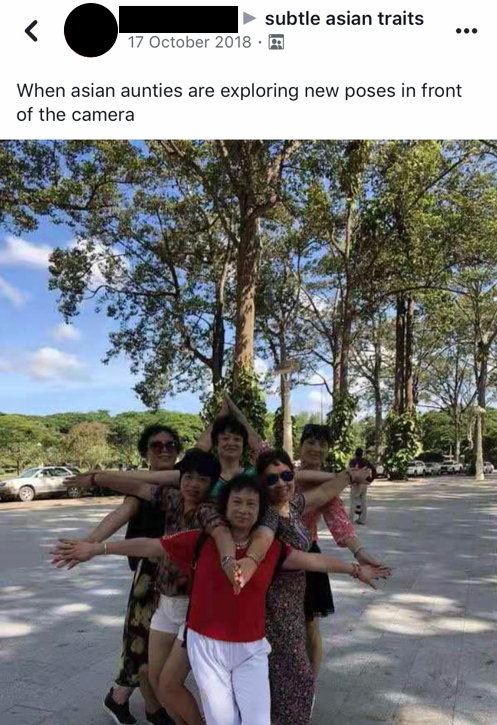
The antics of Asian mums, as seen in an SAT post with over 12k reacts.
Despite its ubiquity among Asian youth, it’s difficult to put a finger on what “subtle asian traits” is, even after a few months in the group. What is the group trying to accomplish, and is there a need to closely question its purpose? For most, it’s a virtual community that subsists on memes and posts about a broadly “Asian” experience—approved by a select group of moderators—but the meteoritic growth of the group has come with difficulties in defining its purpose, estimating its impact, and managing its members and content. Given that SAT was founded as an informal, humorous online space primarily for Asian-Australians in Melbourne, it has adhered to that purpose, and its posting speed has only increased with its ballooning membership. Yet SAT has achieved little else besides serving as a dumping ground for virtually any meme directly related to Asians, leading us to ask: what exactly is SAT trying to accomplish?
Beyond Asian material culture, SAT’s posts often poke fun at the model minority stereotype, and high academic expectations from parents, uniting many members of the community by reclaiming Asian stereotypes in a light-hearted, ironic manner. Occasionally, some speak of ways in which their parents defy these Asian tropes. In many posts, tired medical students elicit “likes” by sharing how their parents forced them into medical school. As of late, numerous posts about the cardinal Asian sin—tattoos—have flooded the group, with some sharing their close shaves hiding them from their strict parents. The sense of camaraderie in seeing someone living in the same boat as you, albeit on the opposite side of the world in, is testament to how SAT has made use of Facebook to create a space for teasing out these shared experiences, and possibly for the first time, providing a dedicated virtual community. Given that many of SAT’s members are second-generation immigrants or settlers in Western countries like Australia and the USA, SAT has become a space to revel in the peculiarities and special quirks of our cultures, which mainstream media and pop culture have often ignored, or failed to present in a nuanced way (think Crazy Rich Asians).
SAT has also sprouted into a series of sub-groups borrowing the “subtle asian” name – subtle asian pets, subtle asian dating, subtle asian Christians, and the like. subtle asian dating was formed as a quasi-joke, but enjoyed unexpected success as SAT’s first “spin-off”, and extended the potential of the original group’s reach. Perhaps the most impactful of the groups is the Asian Creative Network (ACN), which gives Asian artists a platform to showcase their work and connects other groups dedicated to specific cities and art forms. It moves beyond providing sources of online entertainment to help advance the professional interests of Asian creatives all around the world. The network has organized meet-ups in various cities and expects to publish a magazine in the summer of 2019. In the ACN group, creators from all over the world not only inspire one another with their work, but also seek advice from the community: for example, how they should deal with parents who frown upon them following the ‘unpragmatic’ path of art, or work with difficult clients. Given the lack of institutional support or dedicated organisations supporting the careers of Asian creatives across the world, ACN has done an impressive job filling that role, and continues to expand rapidly – not bad for a group that sprang out of a meme page.
As SAT has grown into a global phenomenon, it leaves us wondering how the group can be better managed in the long term, and cope with its own popularity. Can the group sustain its empowering tone and community-building function in the long term, given the multiplicity of the very term “Asian”? With over two billion people living in continental Asia, and far more in overseas communities, it is inevitable that definitions of “Asia” are not able to encompass the entirety of the diaspora. Outside of continental Asia, there are over over 3 million people of East, Southeast, Central and Southern Asian descent living in Australia, and 20 million of Asian or mixed Asian descent in the USA. The global spread of the Asian diaspora means that a singular “Asian” experience is almost impossible to pin down. Western of what “Asia” is were shaped most profoundly in the period from the 1960s to the 1990s, when the “Four Asian Tiger” nations were formed. Singapore, Taiwan, South Korea, and Hong Kong were at that time the most dominant economies in the region, and Western perceptions of “Asia” became centred around these countries, which were renowned for their rapidly rising wealth and global prominence. These countries continue to benefit from their relative wealth vis–vis other nations in the continent, as well as from their sterling reputation for their stability.
South Asian nations like India and Pakistan are often excluded from conversations about the “Asian experience.” SAT demonstrates this reality. While a good number of posts can be deemed inoffensive and broadly applicable to the Pan-Asian community, many are clearly specific to certain nationalities—posts featuring Korean, Chinese and Japanese-language puns are especially popular at the expense of people not already in the know. It is difficult to ascertain if the lack of Southern Asian representation in SAT can be attributed to the lack of diversity among the group’s moderators or their personal biases or otherwise, resulting in them carving out their own social spaces and groups on Facebook. Although India is in actuality as populous as China, a strong Indian presence in the group remains conspicuously absent, probably as a result of the group lacking significant Indian representation from the time of its creation. While SAT has steered clear of memes and posts that mock South Asian cultures, that alone is not enough to ensure that South Asian groups can feel included and welcomed in SAT.
Daniel Vukovich, author of China and Orientalism, goes as far to argue that no one in continental Asia would ever define themselves as “Asian”, as it is largely a Western construct. Within Asia, we’re “Indonesian”, “Singaporean”, “Indian”, or the like, but never simply “Asian” until we enter largely white social structures. The cultural and social heterogeneity of the Asian continent is well-known to virtually every one of us, but SAT chooses “Asian” to represent the entire diaspora as a term of convenience. Perhaps there is no other viable alternative to naming a group that encompasses so many nationalities and ethnicities, but to term a largely East Asian-centric group broadly “Asian” is to inadvertently prize a narrow range of Asian cultural experiences over others. Hence, one must question if SAT really caters to a broad Asian experience, or a predominantly East Asian one. As a Chinese person myself, it’s easy to chuckle at almost every meme, or my experiences reflected in many posts. It’s equally easy to overlook the reality that East Asian culture has been “chosen”, as the face of Asian culture at large, and forcing overlooked groups out of a community that in theory should also encompass Asian nations outside of East Asia.
The East Asian, and primarily Chinese and Korean, cultural hegemony within SAT has resulted in the creation of “subtle curry traits” — a South Asian response to their erasure from the main SAT group. My perceptions of SAT also changed significantly after I discovered “subtle asian activists”: a platform for discussing both general social concerns, Asian activism and sharing reading materials on topics like colonialism and racism. Of late, however, it has welcomed members sick of SAT’s frivolity, and become a space for critiquing SAT’s most problematic posts. Transphobia, racism, and colourism still seep into SAT despite rules frowning upon “hate speech or bullying” and encouraging inclusivity. Many of SAT’s most unsettling posts are saved here for posterity, and many of the members of ‘subtle asian activists’ provide insightful commentary on them.
One of SAT’s most disturbing posts, showing how a very transphobic post can make it past the moderators (mocks the ‘ladyboys’ of Thailand)
Yet ‘subtle asian activists’’ absence from the main SAT group, and generally poor responses to “serious” posts in SAT, pose a significant barrier to user intervention in the SAT community. SAT hence remains a closed chamber of frivolity, its moderators actively deleting post submissions that attempt to engage with hard-hitting issues like internalised racism, all discourse on such issues relegated to spaces outside boba and Pikachu memes. Joining “subtle asian activists” provides an alternate perspective on SAT’s seemingly harmless brand of fun, and is a reminder to carefully consider the type of content that SAT prizes and uploads each day.
(From subtle asian activists member Timothy Phan)
Accusations of SAT’s frivolity and inability to engage with pressing social issues are attributed largely to poor moderation. While largely unseen by group members, the moderators and founders of SAT are integral to the group’s day-to-day operations. The press frenzy surrounding the group in general has revealed that its founders are predominantly Chinese-Australians, while a quick search reveals that the majority of moderators are actually of East Asian descent as well. With a group of racially (and largely, culturally) homogenous moderators to filter all the group’s content comes a need to question the probability of biased moderation, given that East Asians are in the best position to relate to—and approve—East Asian-centric posts. While the founders have claimed in The New York Times that they are “encouraging other communities to contribute” content, no concrete measures have been made to promote acceptance of these posts; perhaps a message broadcast too late for the group to undo its East Asian-centric nature.
This is not to say that the moderators have not made attempts to enact change, or at least commit to more stringent moderation in the future. On 4th February 2019, a long announcement detailing SAT’s rules was uploaded, and rather ironically, with the comments turned off. Deleted posts now include “unoriginal” and repeated content and for the first time since the group’s founding: a ban on transphobic posts, and “inappropriate/derogatory” terminology. Whether these rules will be strongly enforced and impact the content in the group remains to be seen, although they seem promising.
All of SAT’s founders have expressed a desire to create a “safe space” for Asians around the world, “sharing and creating jokes that are readable within a community”, and a desire to fit in away from the largely white power structures of their native Australia. Indeed they have succeeded in forging and growing a community that caters to the people who look like them. Yet numerous cracks have emerged in this brand of harmless fun, and without a clearly defined purpose from its creation, SAT is now perhaps most emblematic of how Facebook groups create virtual communities that subsist on fun and amusement, but spiral into chaos as quickly as they grow. SAT could be much more, but if a series of boba memes continues to satisfy its tag-happy young audience, it will never move beyond the confused state it is in today. ∎
